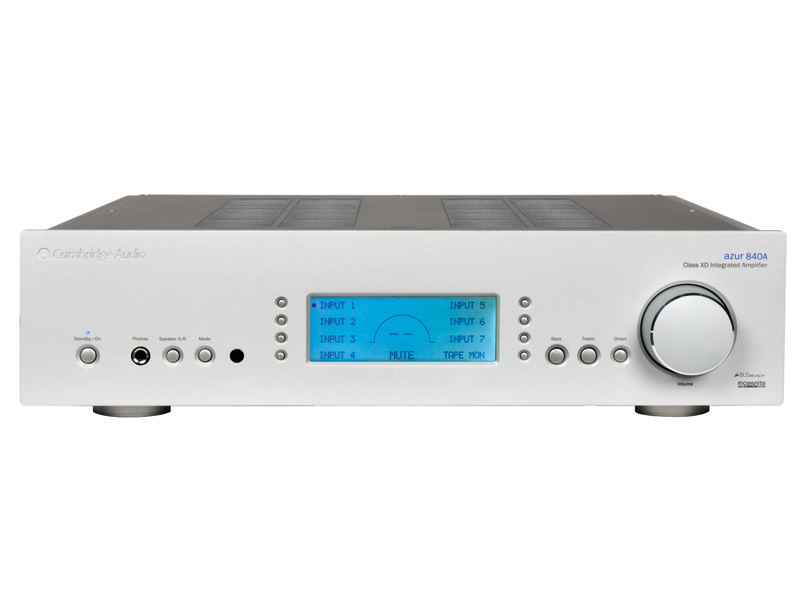TechRadar Verdict
A chunky powerhouse with a lengthy and well-thought-out features list, this amp revels in loud music, but also achieves fine things with subtler tones, including good detail and clear, controlled frequency extremes
Pros
- +
Powerful amp
- +
Loud and lively
- +
Impressive feature set
- +
Strong detail
Cons
- -
Struggles with depth and textures
Why you can trust TechRadar
The Cambridge Audio Azur 840A amplifier has recently acquired 'V2' status, which denotes some minor (though not necessarily unimportant) upgrades to the balanced input and a few other circuit areas.
It's currently the top of the Cambridge Audio integrated amplifier range, and, as such, offers a lot of features, both practical and technical.
Above all, the 'unique selling proposition' of the 840A is its novel output stage. We've all heard about the evils of crossover distortion in amplifiers, which, alas, seem unavoidable without going to the toe-curlingly painful lengths of full Class A operation (high-power Class A amps have been built, but they're inevitably big, hot and very expensive).
Ambitious design
Almost every amplifier designer has dreamed of circumventing crossover problems, but this amp comes nearer to achieving that than most by dint of its 'Class XD' (crossover displacement) output stage, which delays crossover to high output levels without incurring huge power-consumption penalties.
It doesn't completely avoid crossover, but it's an achievement to salute nonetheless. It's achieved in practical terms by a bi-polar transistor circuit, aided by a mains transformer of eyebrow-raising size and ingeniously laid-out circuit boards.
Input-switching and volume control are both achieved by relays, while the rear panel is crammed with connections for nine line-level inputs (one balanced), two switchable speaker outputs and multiroom automation in/out too.
Sign up for breaking news, reviews, opinion, top tech deals, and more.
Build quality is good and the front-panel display is easy to follow. Inputs are simply 'Input 1' and so on by default, but can be renamed, a nice touch.
All-round performer
The 840A may not have ticked all the boxes all the time, but it at least looked at them – detail, bass, treble, rhythm, dynamics, and so on.
One area where it seemed to trump its rivals was in bass detail. Listening to the 840A towards the end of the presentations, one listener commented that he was hearing proper detail from the bass for the first time, and the others also commented in various ways on the increased resolution they could clearly hear in the lowest octaves.
It still didn't quite seem to have the degree of bass attack that one of the listeners reckoned he'd heard in the past, but it still managed a pretty decent performance in that area.
Treble top
Meanwhile, treble was felt to be very clear and open with very good resolution of ambience and the natural decay of percussive sounds.
It seems that dense musical textures aren't always fully resolved by the 840A and, as a result, while it can give an excellent degree of insight into relatively simple recordings, it doesn't always achieve quite the same with multilayered sounds such as an orchestra.
Imaging is good, though depth could perhaps be a little more clearly defined at times. But we can't close this review without referring to one characteristic of which our listening panel was unaware (because of the practicalities of comparing 120-watt amps with 40-watt ones): this amp does take wing when playing loud.
Driving the nuts and bolts off our resident ATC speakers, it made some of the most foot-tapping noises we've heard from a sub-£1,000 amp. That, plus its skills in other areas and undeniable flexibility, makes the Cambridge Audio Azur 840A V2 a recommendable purchase for many.
The TechRadar hive mind. The Megazord. The Voltron. When our powers combine, we become 'TECHRADAR TEAM'. You'll usually see this author name when the entire team has collaborated on a project or an article, whether that's a run-down ranking of our favorite Marvel films, or a round-up of all the coolest things we've collectively seen at annual tech shows like CES and MWC. We are one.
